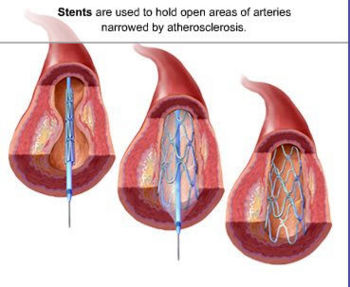Percutaneous transluminal coronary angioplasty
In medicine, percutaneous transluminal coronary angioplasty (PTCA), also called percutaneous coronary intervention (PCI), is a form of myocardial revascularization in which occurs "dilatation of an occluded coronary artery (or arteries) by means of a balloon catheter to restore myocardial blood supply."[1]
| Trial(s) | Intervention | Outcome |
|---|---|---|
| STRESS[2] (1994) |
PCI without stent | 20% (6 months)[2] |
| STRESS[2] (1994) SIRIUS[3] (2003) TYPHOON[4] (2006) |
PCI with bare-metal stents | 14%[4]to 14% (6 months)[2] to 21% (270 days)[3] |
| SIRIUS[3] (2003) TYPHOON[4] (2006) SPIRIT IV[5] (2010) |
PCI with first generation DES | 7%[4][5] to 9% (270 days)[3] |
| SPIRIT IV[5] (2010) |
PCI with second generation DES | 4%[5] |
PTCA may be a treatment for myocardial infarction and an intravascular stent may or may not be left at the site of the stenosis in order to prevent restenosis.[6]
The relief from angina, as compared to relief from medical therapy, may be reduced when evidence-based medications are used.[7]
Stenting
Stenting reduces the rate of restenosis, but should not be done if the patient has extensive stenoses, the stenosis is in a very small coronary artery, or if bypass surgery is planned within a few days.[6]
Drug eluting stents can reduce restenosis rate[4], but should not be used if the patient cannot take clopidogrel.
Effectiveness
Clinical practice guidelines address management and selection of patients.[8]
Complications
Ventricular dysrhythmia during PTCA for myocardial infarction indicates an increased risk for mortality at 3 months.[9]
References
- ↑ Anonymous (2024), Percutaneous transluminal coronary angioplasty (English). Medical Subject Headings. U.S. National Library of Medicine.
- ↑ 2.0 2.1 2.2 2.3 2.4 Fischman DL, Leon MB, Baim DS, Schatz RA, Savage MP, Penn I et al. (1994). "A randomized comparison of coronary-stent placement and balloon angioplasty in the treatment of coronary artery disease. Stent Restenosis Study Investigators.". N Engl J Med 331 (8): 496-501. PMID 8041414.
- ↑ 3.0 3.1 3.2 3.3 3.4 Moses JW, Leon MB, Popma JJ, Fitzgerald PJ, Holmes DR, O'Shaughnessy C et al. (2003). "Sirolimus-eluting stents versus standard stents in patients with stenosis in a native coronary artery.". N Engl J Med 349 (14): 1315-23. DOI:10.1056/NEJMoa035071. PMID 14523139. Research Blogging.
- ↑ 4.0 4.1 4.2 4.3 4.4 4.5 Spaulding C, Henry P, Teiger E, Beatt K, Bramucci E, Carrié D et al. (2006). "Sirolimus-eluting versus uncoated stents in acute myocardial infarction.". N Engl J Med 355 (11): 1093-104. DOI:10.1056/NEJMoa062006. PMID 16971716. Research Blogging.
- ↑ 5.0 5.1 5.2 5.3 5.4 Stone GW, Rizvi A, Newman W, Mastali K, Wang JC, Caputo R et al. (2010). "Everolimus-eluting versus paclitaxel-eluting stents in coronary artery disease.". N Engl J Med 362 (18): 1663-74. DOI:10.1056/NEJMoa0910496. PMID 20445180. Research Blogging.
- ↑ 6.0 6.1 Keeley EC, Hillis LD (2007). "Primary PCI for myocardial infarction with ST-segment elevation". N. Engl. J. Med. 356 (1): 47-54. DOI:10.1056/NEJMct063503. PMID 17202455. Research Blogging.
- ↑ Wijeysundera HC, Nallamothu BK, Krumholz HM, Tu JV, Ko DT (2010). "Meta-analysis: effects of percutaneous coronary intervention versus medical therapy on angina relief.". Ann Intern Med 152 (6): 370-9. DOI:10.1059/0003-4819-152-6-201003160-00007. PMID 20231568. Research Blogging.
- ↑ Levine GN, Bates ER, Blankenship JC, Bailey SR, Bittl JA, Cercek B et al. (2011). "2011 ACCF/AHA/SCAI Guideline for Percutaneous Coronary Intervention: A Report of the American College of Cardiology Foundation/American Heart Association Task Force on Practice Guidelines and the Society for Cardiovascular Angiography and Interventions.". Circulation. DOI:10.1161/CIR.0b013e31823ba622. PMID 22064601. Research Blogging.
- ↑ Mehta, Rajendra H.; Aijing Z. Starr, Renato D. Lopes, Judith S. Hochman, Petr Widimsky, Karen S. Pieper, Paul W. Armstrong, Christopher B. Granger, for the APEX AMI Investigators (2009-05-06). "Incidence of and Outcomes Associated With Ventricular Tachycardia or Fibrillation in Patients Undergoing Primary Percutaneous Coronary Intervention". JAMA 301 (17): 1779-1789. DOI:10.1001/jama.2009.600. Retrieved on 2009-05-06. Research Blogging.
